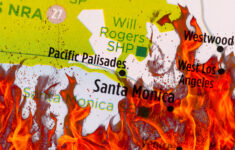A deadly form of soot pollution from U.S. refineries has gone unregulated for decades because of a dispute between the U.S. oil industry and federal environmental officials over how to measure it, according to documents from the Environmental Protection Agency reviewed by Reuters.
The delay in addressing so-called condensable fine particulate matter emissions means this pollutant is being released by scores of facilities across the country unchecked, adding to a slew of other contaminants from oil refineries that researchers say take a disproportionately large toll on the health of poor and minority communities living nearby.
The absence of a federal standard has led at least one regional air quality regulator in California to attempt a crack-down on these emissions, an effort that has sparked litigation from oil refiners located there.
Condensable fine particulate matter is a form of soot that leaves the smokestack as a gas before solidifying into particles when it cools. The EPA first proposed a method to measure it in 1991 amid evidence that it was at least as damaging to human lungs as normal soot, which is solid when emitted.
The agency says even short-term exposure to fine soot particles can lead to heart attacks, lung cancer, asthma attacks and premature death. Scientific research cited by the EPA estimates that, combined, condensable and solid soot cause more than 50,000 premature deaths a year in the United States, findings that are disputed by the industry.
But the EPA has declined to impose limits on the condensable form of the pollutant. The oil industry and its main lobbying group, the American Petroleum Institute (API), claim the agency has failed to come up with an accurate test to quantify it, according to EPA disclosures and interviews with independent testing firms, API officials and the trade group’s members.
The industry says testing employed currently can overstate the amount of condensable soot emitted by refineries under certain conditions, a flaw the EPA has acknowledged.
“Costly retrofits or new control devices should not be required based on results from a faulty method,” major U.S. oil company Chevron Corp told Reuters in a statement.
Setting a national limit on pollutant emissions without consensus on how to measure those emissions is unfeasible because it would invite legal challenges from the industry, according to regulators and stack-testing analysts.
The EPA said in a statement that it is still conducting research into how to reliably measure condensable soot but did not comment on a timeline for finishing the effort.
The delays are dangerous, said Greg Karras, an environmental scientist who has worked for nonprofit groups seeking reduced emissions from the refining industry.
“It is inappropriate to wait more than 30 years to protect people from this form of pollution while you are trying to perfect a test,” Karras said.
If condensable soot were eventually regulated, it would force nearly all the country’s 135 oil refineries to invest in new pollution-control equipment, based on estimates of current emissions using the EPA’s contested testing method.
San Francisco Cracks Down
Soot is comprised of particles many times smaller than a grain of sand that can penetrate the lungs and bloodstream if inhaled. The EPA regulates solid forms of soot, which are easy to measure by filtering smokestack emissions. But because condensable soot is gaseous in the smokestack, it is harder to quantify.
The EPA’s current test for condensable soot, called Method 202, uses probes and glass tubes placed inside refinery smokestacks to collect samples from the gas stream. It shows individual U.S. refineries can emit up to hundreds of tons of the pollutant per year, sometimes accounting for nearly half of a refinery’s total soot emissions, according to a Reuters review of regulatory documents filed by oil companies.
The material examined by the news agency dates from 2017 to 2021 and includes results of Method 202 tests that some refineries had commissioned to meet local requirements or as part of litigation.
The API, however, says the test can produce erroneously high readings of condensable soot if the samples react with other chemicals that commonly are present at a refinery.
The EPA has acknowledged that pollution levels could be overestimated using Method 202, agency disclosures show. The EPA revised Method 202 in 2010 in an attempt to eliminate this bias. But the revision did not fully address industry concerns about potentially skewed results due to the presence of other compounds in refinery smokestacks, particularly ammonia, according to a 2014 EPA memorandum viewed by Reuters.
The EPA’s National Risk Management Research Laboratory in Ohio, which is charged with finding scientific and engineering solutions to environmental problems, is now working with the API on resolving issues with Method 202 while exploring an alternative methodology, the EPA told Reuters.
The long-running issue surfaced last year when regulators in San Francisco’s Bay Area, which includes nine counties around the city of San Francisco, passed the strictest soot regulations in the country in a bid to ease pollution in the neighborhoods around its cluster of oil refineries.
U.S. states and regions are often given the power to impose their own pollution limits provided those rules are as strong, or stronger, than federal regulations.
The Bay Area Air Quality Management District’s (BAAQMD) new limits include condensable soot and require the industry—despite its objections—to use Method 202 to quantify those soot emissions. The agency contends the test is accurate and that condensable soot measurements are not impacted by the presence of ammonia in a smokestack if a refinery is operating properly. The tougher soot standard goes into effect in 2026 to give oil companies time to adapt.
Refining companies Chevron and PBF Energy Inc. are fighting the BAAQMD’s new regulations in Contra Costa County Superior Court, according to a civil complaint filed in September. The companies say the rules would force them to spend hundreds of millions of dollars on pollution-control equipment for their Bay Area refineries.
“API and our members support policies at the federal level that follow the science to drive emissions reductions, but the Bay Area Air Quality Management District is using the wrong approach,” Ron Chittim, API’s vice president of downstream policy, said in a statement to Reuters.
Chevron estimates it would cost $1.48 billion to install a so-called wet gas scrubber at its refinery in Richmond, Calif., a pollution-control approach the BAAQMD wants the company to use.
BAAQMD estimates its restrictions would cut the area’s annual death toll from soot by as much as half. Soot-related deaths currently average up to 12 a year from Chevron’s Richmond refinery and up to six deaths a year from PBF Energy’s refinery in Martinez, Calif., the regulator estimates.
Refiners disputed those figures in comments submitted to BAAQMD staff. The industry says the numbers don’t take into account lifestyle choices of the deceased, such as smoking, and it contends the health benefits from cuts in soot production are exaggerated.
A BAAQMD spokesperson declined further comment, citing ongoing litigation.
New Standard?
It remains to be seen whether other California air quality districts, regulators in other states or the federal government will follow the Bay Area’s lead.
The EPA under President Joe Biden has said it is weighing whether to lower its existing limits for soot pollution after former President Donald Trump’s administration declined to do so. But the agency would not specify whether it planned to crack down on condensable soot.
In Texas, which has the largest number of refineries in the country, the Texas Commission on Environmental Quality said it does not have plans to tighten restrictions on particulate matter, a spokesman said.
Elsewhere, recent test results at two refineries viewed by Reuters showed that condensable soot accounted for a significant portion of overall soot generated by those operations.
In Delaware, at the Delaware City Refinery owned by PBF, 48 percent of the soot measured was condensable soot, according to results from a May stack test performed by an outside consulting firm as part of the facility’s routine compliance with federal air quality regulations.
PBF declined to comment.
At Exxon Mobil Corp’s refinery in Baton Rouge, La., 17 percent of soot measured was condensable, according to an August stack test on file with the Louisiana Department of Environmental Quality.
Exxon declined to comment on the battle over Method 202. The company said it was “continuously optimizing our processes to minimize emissions and enhance energy efficiency.”
(Reporting by Tim McLaughlin in Boston; editing by Richard Valdmanis and Marla Dickerson)





















 As Life Shifts Gears, Insurance CEO Chases Racing Dream
As Life Shifts Gears, Insurance CEO Chases Racing Dream  Leading Insurance Innovation in the AI Age (Part 1: Culture)
Leading Insurance Innovation in the AI Age (Part 1: Culture)  Moody’s RMS Adds to LA Fires Insured Loss Estimates With Range of $20B-$30B
Moody’s RMS Adds to LA Fires Insured Loss Estimates With Range of $20B-$30B  Executives on the Move at Everest Group, Zurich NA, Arch Capital, Plymouth Rock and Intact Financial Corp.
Executives on the Move at Everest Group, Zurich NA, Arch Capital, Plymouth Rock and Intact Financial Corp. 